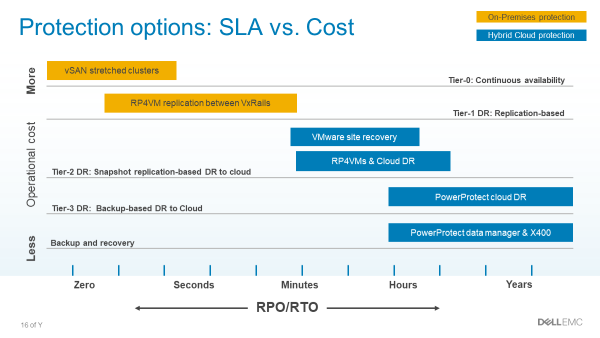As customers are facing explosive data growth in their data centers – 163 ZB of data by 2025 – it has become imperative for businesses to protect and manage that data as well. However, data protection in the traditional data center can be inefficient, expensive, complex, and require multiple vendors. Dell EMC’s data protection solutions can simplify these complexities through integration, scalability, and automation to empower data owners with the necessary tools to meet the needs of fast-growing organizations of any size.
Colin Durocher, Product Manager from Dell EMC, and KJ Bedard, VxRail Technical Marketing Manager from Dell EMC, recently presented about VxRail leading the HCI market by combining best-of-breed technologies to simplify the path towards the VMware cloud.
Powered by VMware vSAN, VxRail transforms IT faster. VxRail consolidates compute, storage and virtualization with end-to-end lifecycle management. VxRail customers see a 52% reduction in time spent on infrastructure deployment tasks. VxRail includes a full suite of software including data protection and recovery provided by snapshots and stretched cluster technology, ensuring data efficiency services that are ready for any virtualized workload. VxRail’s resilient architecture protects the integrity of virtual machines (VMs) as well as the individual profiles for each VM.

With VxRail, Dell EMC can meet any RPO/RTO service level objective and covers the widest ecosystem of applications and environments. Specifically, the VxRail data protection deployment schema has five data protection solutions in private and hybrid cloud disaster recovery (DR).
The three private cloud data protection solutions satisfy Tier-0, Tier-1 and local data protection.
- VxRail Active – active stretch clustering for Tier-0 data protection. This solution provides continuous availability with local clusters for site level protection with zero data loss and near instantaneous recovery, as well as automated failover in case of site failures. Stretched clusters can also support a minimum of 3 nodes per site (local and remote) and a maximum of 15 nodes per site; 15 on local and 15 on remote. Benefits include using stretched clustering for disaster avoidance, planned maintenance activities, zero RPO, and upgrades are not customer driven and require contacting support. With site failure, vSAN maintains availability with local redundancy in surviving site, while requiring no change in stretched cluster configuration steps.
- Tier-1 DR between sites, powered by RecoverPoint for Virtual Machines (RP4VMs). Architecturally, RP4VMs provide no single point of failure in non-cloud deployments, as well as sync, async, or dynamic replication. This enables data recovery to any point-in-time (PiT), locally or remotely. RP4VMs can be used in a multitude of use cases such as operational recovery in case of data damage, migration and data protection, automated disaster recovery, and data reuse. However, RP4VMs are not licensed with the PowerProtect X400 appliance.
- Local data protection because modern data centers need next generation data management software, and customers can extend Dell EMC on-premises with the Dell EMC PowerProtect X400 appliance and software, powered by Data Domain’s deduplication technology.

The Dell EMC PowerProtect X400 particularly makes sense for the VxRail because it has the same hardware, making it a fit for HCI. The hardware is optimized for data protection instead of having a separate VxRail cluster for data protection, and it can scale-out like a VxRail.

VxRail currently offers two end-to-end hybrid cloud DR solutions. The two hybrid cloud DR solutions satisfy Tier-2 and beyond
- Tier-2 DR or VMware site recovery for VMware Cloud™ on AWS combines the power of Site Recovery Manager with vSphere replication and the elasticity and simplicity of the cloud. This solution provides a 1-click DR automation for low RTOs, as well as a hypervisor based VM replication, which copies snapshots to the remote site. VMware site recovery for VMware Cloud™ on AWS is equipped with ready-to-go infrastructure in the cloud and offers DR as a Service (DRaaS).
- RP4VMs replicate the data to AWS S3 storage, offering customers a low-cost DR site. Cloud DR recovers to VMware Cloud™ on AWS on-demand, provides consistency, and a familiar UI for vAdmins. Additionally, RP4VMs can be combined with local and remote snapshots for any-PiT protection.

These data protection approaches discussed in the webinar provide customers with the performance and simplicity that they need to address the operational and compliance requirements for the modern SDDC. Business needs combined with financial constraints drive the right solution for any given application and customers with variety of applications may elect to have a variety of solutions, but PowerProtect covers most of the space. With VxRail and VMware, Dell EMC offers the full spectrum of data protection solutions for any environment. This is just another example of how Dell EMC and VMware are better together.
To learn more: https://www.dellemc.com/en-us/data-protection/protection-vmware.htm#collapse
Additional Resources:
Click here for the Moving DR to the Cloud Webinar
Click here for How VMware and Dell EMC simplify, automate and protect your organization blog
Click here for the Optimize Data Protection for VxRail Brochure
